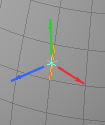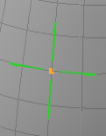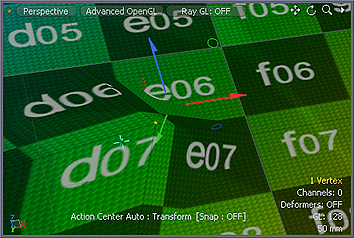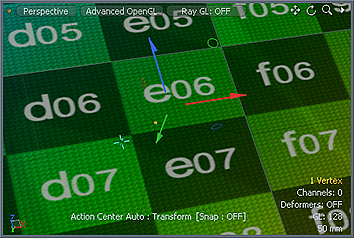Slide
The Slide tool moves selected mesh elements (vertices, edges and polygons) along their connected edges. There are two tool modes (Radial and Linear) which can be used depending on the style of selection and intended result.
Activating the Slide Tool
• In the Model layout, on the left panel, open the Edge tab, and click Slide.
• In the Topology layout, on the left panel, open the Tools tab, and click Edge Slide.
• On the menu bar, click Geometry > Slide.
Or
• Press S.
Using Selection Modes

• In the Edges or Polygons selection mode, with Mode set to Linear, the Slide tool displays the available slide vectors.

• When using the Vertices selection mode, with Mode set to Linear, the Slide tool displays the available slide vectors. When activated, Select Through is enabled.

For more information about selection modes, see Selecting Items.
Sliding an Edge Using Linear Mode
| 1. | Click Edges and select an edge. |

Tip: Hold Shift and click to add more edges to the selection. You can select multiple edges by clicking and dragging or right-click lassoing.
| 2. | Press S to activate the Slide tool. |
Alternatively, on the left panel, open the Edge tab and click Slide.
| 3. | On the left panel, in the Slide properties, set Mode to Linear. |

| 4. | Click and drag on one of the handles to slide the edge(s) into a new position. |

| 5. | Press Esc to drop the tool. |
Sliding a Vertex Using Linear Mode
| 1. | Click Vertices and select a vertex on your mesh item. |

| 2. | Press S to activate the Slide tool. |

| 3. | On the left panel, in the Slide properties, set Mode to Linear. |

| 4. | Ensure that the Select Through button is enabled. |

| 5. | Click and drag on one of the handles. |

| 6. | Press Spacebar to drop the tool handles. |
| 7. | Hold Shift and select a number of additional vertices. |
| 8. | Press S and click and drag on a handle. |

| 9. | Press Esc to drop the tool. |
Slide Tool Properties

|
Mode |
• Radial Mode - When enabled, the Direction fields are disabled. The input values for Distance and Percentage specifies how far to slide the selected loop between the next and previous loops. For example, use this mode for sliding entire edge loops such as widening or narrowing a selected edge loop around an eye. • Linear Mode - Slides elements along either of two intersecting edges. This is useful when sliding vertices or polygon selections. When enabled, the Direction X/Y/Z triplet is activated. |
|||||
| Direction X/Y/Z | Sets the directional position for X, Y, and Z. | |||||
|
Allows you to choose between Distance and Percent methods for sliding the geometry. • When Distance is enabled, the Distance option is enabled. • When Percent is enabled, the Percentage option is enabled. |
||||||
|
When Interpolation is set to Distance, set the numeric value and unit system used to move the geometry. |
||||||
|
When Interpolation is set to Percent, set the percentage value to slide the selected geometry. You can set the percentage using its initial position (0%) and to the neighboring edge or edge loop position (-100% - 100%). |
||||||
|
Merge Vertices |
When enabled, vertices are merged when vertices share the same coordinates. For example, sliding an edge 100% results in that edge being merged into its neighbor. Tip: This can be particularly useful when combined with the Stop at Edges option to avoid over deforming geometry. |
|||||
|
When enabled, the Slide tool stops the slide when the selected mesh elements reach the surrounding edges. |
||||||
|
Duplicate |
When enabled, creates a new edge rather than sliding to the selected edge. Tip: Use this option to create new edges or edge loops and place them along the existing curve. |
|||||
|
Loop Slide |
When enabled and sliding on an edge selection, constrains the movement along the existing polygonal bounds. |
|||||
|
Segments |
Specifies the number of segments for profiles. If value is 0 and a profile is selected, the Slide tool automatically decides the best adaptive segments for the profile. Note: Duplicate must be enabled for Profiles to work. To specify a profile, see Profiles Options. |
|||||
|
When enabled, the new position is computed along a curve through the edges to maintain the overall curvature or surface continuity. Once enabled, the Tension setting becomes available, controlling the tightness of the curvature preservation. |
||||||
|
Determines the strength of the curvature preservation. The default value of 100% calculates the curvature, placing the new vertex appropriately. Note: Setting the value to 0% disables the Preserve Curvature option. Negative values inset the curvature and higher values further offset the vertex out from the curve's position. |
||||||
|
Slip UVs
|
When enabled, existing UV mappings applied to the geometry are not disturbed. For more information about UV Mapping, see Working with UV Maps. |
|||||
|
||||||
| Handle Line Size | Specifies the line width of vertex handle. | |||||
| Apply | Applies property settings. |
Profile Attributes Options
| Inset | This specifies the offset amount of X direction of the profile. |
| Reverse Direction | If this option is enabled, the 1D profile is evaluated from top to bottom. |
| Reverse Inset | If this option is enabled, Inset is reversed. |
| Keep Aspect | Automatically sets Inset value based on the aspect ratio of the profile. |
Profiles Options
Mini Preset browser for viewing various profiles. Works the same as the standard Preset Browser.

